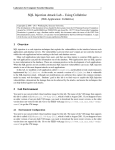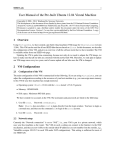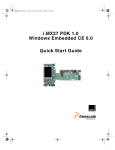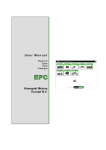Download Efficient Networks PCI 10/100 Network Card User Manual
Transcript
LED Functions Adapter Installation Problems The following table describes the operation of the SpeedStream® 1020 PCI adapter’s status LED. If your computer cannot find the SpeedStream® 1020 PCI adapter, or if the network driver does not install correctly, check the following: 007-0120-001 • Make sure the adapter is securely seated in the PCI slot. Check for any hardware problems, such as physical damage to the card’s edge connector. COLOR STATUS DESCRIPTION Amber On Indicates a valid 10Base-TX link Amber Flashing Indicates 10 Mbps network activity Green On Indicates a valid 100Base-TX link Green Flashing Indicates 100 Mbps network activity • Try the card in another PCI bus-master slot. If this fails, test with another PCI adapter that is known to operate correctly. • Check for resource conflicts in the PCI configuration. (See ‘PCI Compatibility.’) • Make sure your computer is using the latest BIOS available. • If there are other network adapters in the computer, they may be causing a conflict. Remove all other adapters from the computer and test the SpeedStream® PCI adapter separately. • Check for a defective computer or PCI bus by trying the adapter in another computer that is known to operate correctly. Troubleshooting Network Connection Problems Check the following troubleshooting items before contacting Technical Support. There may be a network connection problem if the LED on the card’s bracket does not light, or if you cannot access any network resources from the computer. Check the following: PCI Compatibility • Be sure you are using Category 5 cable for 100 Mbps connections and that the length of any cable does not exceed 328 ft (100 meters). Some computers are not self-configuring and require you to perform some or all of the following functions. You may need to change the motherboard jumper settings and/or Setup program configuration. Refer to your computer's manual for configuration procedures specific to your computer components. • Make sure your BIOS correctly supports the PCI Local Bus Specification v2.0 or later. Upgrade your computer BIOS to the latest version. • Verify that the PCI slot is an enabled bus-master slot and not a slave PCI slot. In some computers, the PCI slot must be configured to enable bus mastering. • Inspect all network cables and connections. Make sure the network cable is securely attached to the card’s connector. • Make sure the correct network card driver is installed for your operating system. If necessary, try reinstalling the driver. • Make sure the computer and other network devices are receiving power. If you suspect a faulty power outlet, plug another device into it to verify that it is working. • If resources are not properly assigned between installed cards, you may be required to disable Plugand-Play in the BIOS Setup program. Refer to your computer manual for instructions. • If the network card’s speed or duplex mode has been configured manually, check that it matches that of the attached network device port. It is recommended that you set the card to auto-negotiation when installing the network driver. • Some computers may require you to reserve interrupts and memory addresses for installed ISA cards in order to prevent PCI cards from using the same settings. • The port on the network device that the card is attached to may be defective. Try using another port on the device. • Make sure the PCI slot is configured to support INTA. • If you cannot access a Windows® or NetWare service on the network, check that you have enabled and configured the service correctly. If you cannot connect to a particular server, be sure that you have access rights and a valid ID and password. • Be sure that INTA for the slot is assigned to a free interrupt (IRQ) number. • Check the PCI parameters in the BIOS setup program for the slot where the SpeedStream® PCI adapter is installed. Be sure the slot is configured for level-triggered interrupts instead of edge-triggered interrupts. An example of typical PCI parameters follows: PCI Slot #: Master: (slot number where the network card is installed) Enabled Slave: Enabled Latency Timer: 40 (range is 20 to 255) Interrupt Type: Interrupt Number: • If you cannot access the Internet, be sure you have configured your system for TCP/IP. Technical Support for North America is available 24 hours a day, 7 days a week, by phone, email or online: Phone: Email: Online: SpeedStream® 1020 PCI 10/100 Ethernet Adapter 1-877-823-6722 [email protected] http://www.support.speedstream.com Level-Triggered (choose any number the BIOS setup provides that does not conflict with another installed card) Note: The wording of these parameters varies with different computers, and not all parameters may be configurable. Always consult your computer manual for information on changing motherboard jumper settings and BIOS setup program parameters for use with PCI network cards. If you set a motherboard jumper and modify the computer BIOS setup, make sure the jumper and BIOS settings match. For more information regarding SpeedStream® products visit: www.speedstream.com. Efficient Networks, Inc. A Siemens Company 4849 Alpha Road Dallas, TX 75244 ©2001 Efficient Networks, Inc. All rights reserved. Efficient Networks, its logos, "Live a Broadband Life" and SpeedStream are registered and unregistered trademarks of Efficient Networks, Inc. Siemens and the Siemens logo are registered trademarks of Siemens AG, Germany. All other brand names and trademarks are held by their respective companies. Efficient Networks reserves the right to make changes to product specifications at any time without notice. Quick-Start Guide Before you begin: Step 1 Hardware Installation Network cards are sensitive to static electricity. Avoid touching its electrical components. To eliminate static electricity, always touch the chassis of your computer before handling the card. Backup your driver and use the copy as the working copy to protect the original from accidental damage. Package Contents Your package includes the following: FREE E X T E N D E D WA R R A N T Y ! 1. Switch off the computer, unplug the power cord, and remove the computer cover. 2. Select an unused PCI bus-master slot and remove its protective bracket. 3. Carefully insert the card and press until the whole edge connector is firmly seated inside the slot. 4. Screw the card’s bracket securely into the PC chassis. 5. (Optional step) Attach the optional Wake-On-LAN cable. If you require Wake-On-LAN capability from a powered-off state, attach one end of the three-pin Wake-On-LAN cable to the connector on the top edge of the card. Attach the other end to the "5 V Standby" connector on the computer’s motherboard. To locate this connector, refer to your computer’s installation manual. 6. Connect the SpeedStream® 1020 PCI adapter directly to a 10Base-T or 100Base-TX hub or switch using UTP cable. The maximum allowable length of UTP cable connections is 328 ft (100 meters). 7. Replace the computer cover; then power on the computer. The computer BIOS should automatically configure the SpeedStream® 1020 PCI adapter. However, if you have an older computer, you may have to manually configure the computer’s BIOS settings. For more information, see the Troubleshooting section of this Quick-Start Guide. 8. Install the appropriate network driver for your operating system. The driver floppy disk that accompanies the SpeedStream® 1020 PCI adapter contains all the network operating system drivers supported by this card. Please read the “RELEASE.TXT” file on the floppy disk for a list of all drivers. A text file included in each folder details the proper installation procedure for that operating system. 4 3 G E T A O N E Y E A R H A R D WA R E WA R R A N T Y E X T E N S I O N O N Y O U R S P E E D S T R E A M P R O D U C T. JUST GO TO Safety and Certification SpeedStream® Quick s www.speedstream.com/reg/extwrnty L i v e a B r o a d b a n d L i f e ™ -Start Guide thi to s re whe ion , epto kno wedu cat . KePC r t, DSLt info r you por duc neafor sup pro go and new w w w . s p e e d s t r e a m . c o m 007-0105-002 This offer may be revoked, amended, supplemented, revised, altered, changed or terminated at any time without notice in the sole and absolute discretion of Efficient Networks, Inc. This offer is available on select products only. This offer is available in select countries only. The offer is good for thirty (30) days from the date of installation. Offer void where prohibited by law. Certain restrictions may apply. © 2001 Efficient Networks, Inc. A Siemens Company PCI 10/100 Ethernet Adapter Wake-On-LAN Cable Quick-Start Guide Safety and Certification information Extended Warranty and Registration card Floppy disk containing documentation and drivers 5 6 Testing Program: If the host computer does not automatically configure the SpeedStream® 1020 PCI adapter, or if there is a problem with the card, run the DOS-based Testing Program to view the computer’s BIOS settings. Boot the computer to a full DOS environment (not a DOS window) and run the Testing Program, “ACCTEST.EXE”, from the driver floppy disk. If any of the diagnostic tests fail, reboot your computer and run the diagnostics again to see if the problem persists. If it does, record the failure indicated and contact Technical Support for assistance. COL 5-port Ethernet Hub/Switch 7 Note: You will also need a Phillips® screwdriver and the instruction manual that came with your computer. Quick Setup of your Personal Computer 2 Phillips® screwdriver Computer manual Hub PWR 1 Hardware installation is complete. See reverse for LED and troubleshooting information. Before you begin: Step 1 Hardware Installation Network cards are sensitive to static electricity. Avoid touching its electrical components. To eliminate static electricity, always touch the chassis of your computer before handling the card. Backup your driver and use the copy as the working copy to protect the original from accidental damage. Package Contents Your package includes the following: FREE E X T E N D E D WA R R A N T Y ! 1. Switch off the computer, unplug the power cord, and remove the computer cover. 2. Select an unused PCI bus-master slot and remove its protective bracket. 3. Carefully insert the card and press until the whole edge connector is firmly seated inside the slot. 4. Screw the card’s bracket securely into the PC chassis. 5. (Optional step) Attach the optional Wake-On-LAN cable. If you require Wake-On-LAN capability from a powered-off state, attach one end of the three-pin Wake-On-LAN cable to the connector on the top edge of the card. Attach the other end to the "5 V Standby" connector on the computer’s motherboard. To locate this connector, refer to your computer’s installation manual. 6. Connect the SpeedStream® 1020 PCI adapter directly to a 10Base-T or 100Base-TX hub or switch using UTP cable. The maximum allowable length of UTP cable connections is 328 ft (100 meters). 7. Replace the computer cover; then power on the computer. The computer BIOS should automatically configure the SpeedStream® 1020 PCI adapter. However, if you have an older computer, you may have to manually configure the computer’s BIOS settings. For more information, see the Troubleshooting section of this Quick-Start Guide. 8. Install the appropriate network driver for your operating system. The driver floppy disk that accompanies the SpeedStream® 1020 PCI adapter contains all the network operating system drivers supported by this card. Please read the “RELEASE.TXT” file on the floppy disk for a list of all drivers. A text file included in each folder details the proper installation procedure for that operating system. 4 3 G E T A O N E Y E A R H A R D WA R E WA R R A N T Y E X T E N S I O N O N Y O U R S P E E D S T R E A M P R O D U C T. JUST GO TO Safety and Certification s SpeedStream® Quick -Start Guide www.speedstream.com/reg/extwrnty L i v e a B r o a d b a n d L i f e ™ thi to s re whe ion , epto kno wedu cat . KePC r t, DSLt info r you por duc neafor sup pro go and new w w w . s p e e d s t r e a m . c o m 007-0105-002 This offer may be revoked, amended, supplemented, revised, altered, changed or terminated at any time without notice in the sole and absolute discretion of Efficient Networks, Inc. This offer is available on select products only. This offer is available in select countries only. The offer is good for thirty (30) days from the date of installation. Offer void where prohibited by law. Certain restrictions may apply. © 2001 Efficient Networks, Inc. A Siemens Company PCI 10/100 Ethernet Adapter Wake-On-LAN Cable Quick-Start Guide Safety and Certification information Extended Warranty and Registration card Floppy disk containing documentation and drivers 5 6 Testing Program: If the host computer does not automatically configure the SpeedStream® 1020 PCI adapter, or if there is a problem with the card, run the DOS-based Testing Program to view the computer’s BIOS settings. Boot the computer to a full DOS environment (not a DOS window) and run the Testing Program, “ACCTEST.EXE”, from the driver floppy disk. If any of the diagnostic tests fail, reboot your computer and run the diagnostics again to see if the problem persists. If it does, record the failure indicated and contact Technical Support for assistance. COL 5-port Ethernet Hub/Switch 7 Note: You will also need a Phillips® screwdriver and the instruction manual that came with your computer. Quick Setup of your Personal Computer 2 Phillips® screwdriver Computer manual Hub PWR 1 Hardware installation is complete. See reverse for LED and troubleshooting information. Before you begin: Step 1 Hardware Installation Network cards are sensitive to static electricity. Avoid touching its electrical components. To eliminate static electricity, always touch the chassis of your computer before handling the card. Backup your driver and use the copy as the working copy to protect the original from accidental damage. Package Contents Your package includes the following: FREE E X T E N D E D WA R R A N T Y ! 1. Switch off the computer, unplug the power cord, and remove the computer cover. 2. Select an unused PCI bus-master slot and remove its protective bracket. 3. Carefully insert the card and press until the whole edge connector is firmly seated inside the slot. 4. Screw the card’s bracket securely into the PC chassis. 5. (Optional step) Attach the optional Wake-On-LAN cable. If you require Wake-On-LAN capability from a powered-off state, attach one end of the three-pin Wake-On-LAN cable to the connector on the top edge of the card. Attach the other end to the "5 V Standby" connector on the computer’s motherboard. To locate this connector, refer to your computer’s installation manual. 6. Connect the SpeedStream® 1020 PCI adapter directly to a 10Base-T or 100Base-TX hub or switch using UTP cable. The maximum allowable length of UTP cable connections is 328 ft (100 meters). 7. Replace the computer cover; then power on the computer. The computer BIOS should automatically configure the SpeedStream® 1020 PCI adapter. However, if you have an older computer, you may have to manually configure the computer’s BIOS settings. For more information, see the Troubleshooting section of this Quick-Start Guide. 8. Install the appropriate network driver for your operating system. The driver floppy disk that accompanies the SpeedStream® 1020 PCI adapter contains all the network operating system drivers supported by this card. Please read the “RELEASE.TXT” file on the floppy disk for a list of all drivers. A text file included in each folder details the proper installation procedure for that operating system. 4 3 G E T A O N E Y E A R H A R D WA R E WA R R A N T Y E X T E N S I O N O N Y O U R S P E E D S T R E A M P R O D U C T. JUST GO TO Safety and Certification s SpeedStream® Quick -Start Guide www.speedstream.com/reg/extwrnty L i v e a B r o a d b a n d L i f e ™ thi to s re whe ion , epto kno wedu cat . KePC r t, DSLt info r you por duc neafor sup pro go and new w w w . s p e e d s t r e a m . c o m 007-0105-002 This offer may be revoked, amended, supplemented, revised, altered, changed or terminated at any time without notice in the sole and absolute discretion of Efficient Networks, Inc. This offer is available on select products only. This offer is available in select countries only. The offer is good for thirty (30) days from the date of installation. Offer void where prohibited by law. Certain restrictions may apply. © 2001 Efficient Networks, Inc. A Siemens Company PCI 10/100 Ethernet Adapter Wake-On-LAN Cable Quick-Start Guide Safety and Certification information Extended Warranty and Registration card Floppy disk containing documentation and drivers 5 6 Testing Program: If the host computer does not automatically configure the SpeedStream® 1020 PCI adapter, or if there is a problem with the card, run the DOS-based Testing Program to view the computer’s BIOS settings. Boot the computer to a full DOS environment (not a DOS window) and run the Testing Program, “ACCTEST.EXE”, from the driver floppy disk. If any of the diagnostic tests fail, reboot your computer and run the diagnostics again to see if the problem persists. If it does, record the failure indicated and contact Technical Support for assistance. COL 5-port Ethernet Hub/Switch 7 Note: You will also need a Phillips® screwdriver and the instruction manual that came with your computer. Quick Setup of your Personal Computer 2 Phillips® screwdriver Computer manual Hub PWR 1 Hardware installation is complete. See reverse for LED and troubleshooting information. LED Functions Adapter Installation Problems The following table describes the operation of the SpeedStream® 1020 PCI adapter’s status LED. If your computer cannot find the SpeedStream® 1020 PCI adapter, or if the network driver does not install correctly, check the following: 007-0120-001 • Make sure the adapter is securely seated in the PCI slot. Check for any hardware problems, such as physical damage to the card’s edge connector. COLOR STATUS DESCRIPTION Amber On Indicates a valid 10Base-TX link Amber Flashing Indicates 10 Mbps network activity Green On Indicates a valid 100Base-TX link Green Flashing Indicates 100 Mbps network activity • Try the card in another PCI bus-master slot. If this fails, test with another PCI adapter that is known to operate correctly. • Check for resource conflicts in the PCI configuration. (See ‘PCI Compatibility.’) • Make sure your computer is using the latest BIOS available. • If there are other network adapters in the computer, they may be causing a conflict. Remove all other adapters from the computer and test the SpeedStream® PCI adapter separately. • Check for a defective computer or PCI bus by trying the adapter in another computer that is known to operate correctly. Troubleshooting Network Connection Problems Check the following troubleshooting items before contacting Technical Support. There may be a network connection problem if the LED on the card’s bracket does not light, or if you cannot access any network resources from the computer. Check the following: PCI Compatibility • Be sure you are using Category 5 cable for 100 Mbps connections and that the length of any cable does not exceed 328 ft (100 meters). Some computers are not self-configuring and require you to perform some or all of the following functions. You may need to change the motherboard jumper settings and/or Setup program configuration. Refer to your computer's manual for configuration procedures specific to your computer components. • Make sure your BIOS correctly supports the PCI Local Bus Specification v2.0 or later. Upgrade your computer BIOS to the latest version. • Verify that the PCI slot is an enabled bus-master slot and not a slave PCI slot. In some computers, the PCI slot must be configured to enable bus mastering. • Inspect all network cables and connections. Make sure the network cable is securely attached to the card’s connector. • Make sure the correct network card driver is installed for your operating system. If necessary, try reinstalling the driver. • Make sure the computer and other network devices are receiving power. If you suspect a faulty power outlet, plug another device into it to verify that it is working. • If resources are not properly assigned between installed cards, you may be required to disable Plugand-Play in the BIOS Setup program. Refer to your computer manual for instructions. • If the network card’s speed or duplex mode has been configured manually, check that it matches that of the attached network device port. It is recommended that you set the card to auto-negotiation when installing the network driver. • Some computers may require you to reserve interrupts and memory addresses for installed ISA cards in order to prevent PCI cards from using the same settings. • The port on the network device that the card is attached to may be defective. Try using another port on the device. • Make sure the PCI slot is configured to support INTA. • If you cannot access a Windows® or NetWare service on the network, check that you have enabled and configured the service correctly. If you cannot connect to a particular server, be sure that you have access rights and a valid ID and password. • Be sure that INTA for the slot is assigned to a free interrupt (IRQ) number. • Check the PCI parameters in the BIOS setup program for the slot where the SpeedStream® PCI adapter is installed. Be sure the slot is configured for level-triggered interrupts instead of edge-triggered interrupts. An example of typical PCI parameters follows: PCI Slot #: Master: (slot number where the network card is installed) Enabled Slave: Enabled Latency Timer: 40 (range is 20 to 255) Interrupt Type: Interrupt Number: • If you cannot access the Internet, be sure you have configured your system for TCP/IP. Technical Support for North America is available 24 hours a day, 7 days a week, by phone, email or online: Phone: Email: Online: SpeedStream® 1020 PCI 10/100 Ethernet Adapter 1-877-823-6722 [email protected] http://www.support.speedstream.com Level-Triggered (choose any number the BIOS setup provides that does not conflict with another installed card) Note: The wording of these parameters varies with different computers, and not all parameters may be configurable. Always consult your computer manual for information on changing motherboard jumper settings and BIOS setup program parameters for use with PCI network cards. If you set a motherboard jumper and modify the computer BIOS setup, make sure the jumper and BIOS settings match. For more information regarding SpeedStream® products visit: www.speedstream.com. Efficient Networks, Inc. A Siemens Company 4849 Alpha Road Dallas, TX 75244 ©2001 Efficient Networks, Inc. All rights reserved. Efficient Networks, its logos, "Live a Broadband Life" and SpeedStream are registered and unregistered trademarks of Efficient Networks, Inc. Siemens and the Siemens logo are registered trademarks of Siemens AG, Germany. All other brand names and trademarks are held by their respective companies. Efficient Networks reserves the right to make changes to product specifications at any time without notice. Quick-Start Guide LED Functions Adapter Installation Problems The following table describes the operation of the SpeedStream® 1020 PCI adapter’s status LED. If your computer cannot find the SpeedStream® 1020 PCI adapter, or if the network driver does not install correctly, check the following: 007-0120-001 • Make sure the adapter is securely seated in the PCI slot. Check for any hardware problems, such as physical damage to the card’s edge connector. COLOR STATUS DESCRIPTION Amber On Indicates a valid 10Base-TX link Amber Flashing Indicates 10 Mbps network activity Green On Indicates a valid 100Base-TX link Green Flashing Indicates 100 Mbps network activity • Try the card in another PCI bus-master slot. If this fails, test with another PCI adapter that is known to operate correctly. • Check for resource conflicts in the PCI configuration. (See ‘PCI Compatibility.’) • Make sure your computer is using the latest BIOS available. • If there are other network adapters in the computer, they may be causing a conflict. Remove all other adapters from the computer and test the SpeedStream® PCI adapter separately. • Check for a defective computer or PCI bus by trying the adapter in another computer that is known to operate correctly. Troubleshooting Network Connection Problems Check the following troubleshooting items before contacting Technical Support. There may be a network connection problem if the LED on the card’s bracket does not light, or if you cannot access any network resources from the computer. Check the following: PCI Compatibility • Be sure you are using Category 5 cable for 100 Mbps connections and that the length of any cable does not exceed 328 ft (100 meters). Some computers are not self-configuring and require you to perform some or all of the following functions. You may need to change the motherboard jumper settings and/or Setup program configuration. Refer to your computer's manual for configuration procedures specific to your computer components. • Make sure your BIOS correctly supports the PCI Local Bus Specification v2.0 or later. Upgrade your computer BIOS to the latest version. • Verify that the PCI slot is an enabled bus-master slot and not a slave PCI slot. In some computers, the PCI slot must be configured to enable bus mastering. • Inspect all network cables and connections. Make sure the network cable is securely attached to the card’s connector. • Make sure the correct network card driver is installed for your operating system. If necessary, try reinstalling the driver. • Make sure the computer and other network devices are receiving power. If you suspect a faulty power outlet, plug another device into it to verify that it is working. • If resources are not properly assigned between installed cards, you may be required to disable Plugand-Play in the BIOS Setup program. Refer to your computer manual for instructions. • If the network card’s speed or duplex mode has been configured manually, check that it matches that of the attached network device port. It is recommended that you set the card to auto-negotiation when installing the network driver. • Some computers may require you to reserve interrupts and memory addresses for installed ISA cards in order to prevent PCI cards from using the same settings. • The port on the network device that the card is attached to may be defective. Try using another port on the device. • Make sure the PCI slot is configured to support INTA. • If you cannot access a Windows® or NetWare service on the network, check that you have enabled and configured the service correctly. If you cannot connect to a particular server, be sure that you have access rights and a valid ID and password. • Be sure that INTA for the slot is assigned to a free interrupt (IRQ) number. • Check the PCI parameters in the BIOS setup program for the slot where the SpeedStream® PCI adapter is installed. Be sure the slot is configured for level-triggered interrupts instead of edge-triggered interrupts. An example of typical PCI parameters follows: PCI Slot #: Master: (slot number where the network card is installed) Enabled Slave: Enabled Latency Timer: 40 (range is 20 to 255) Interrupt Type: Interrupt Number: • If you cannot access the Internet, be sure you have configured your system for TCP/IP. Technical Support for North America is available 24 hours a day, 7 days a week, by phone, email or online: Phone: Email: Online: SpeedStream® 1020 PCI 10/100 Ethernet Adapter 1-877-823-6722 [email protected] http://www.support.speedstream.com Level-Triggered (choose any number the BIOS setup provides that does not conflict with another installed card) Note: The wording of these parameters varies with different computers, and not all parameters may be configurable. Always consult your computer manual for information on changing motherboard jumper settings and BIOS setup program parameters for use with PCI network cards. If you set a motherboard jumper and modify the computer BIOS setup, make sure the jumper and BIOS settings match. For more information regarding SpeedStream® products visit: www.speedstream.com. Efficient Networks, Inc. A Siemens Company 4849 Alpha Road Dallas, TX 75244 ©2001 Efficient Networks, Inc. All rights reserved. Efficient Networks, its logos, "Live a Broadband Life" and SpeedStream are registered and unregistered trademarks of Efficient Networks, Inc. Siemens and the Siemens logo are registered trademarks of Siemens AG, Germany. All other brand names and trademarks are held by their respective companies. Efficient Networks reserves the right to make changes to product specifications at any time without notice. Quick-Start Guide
















